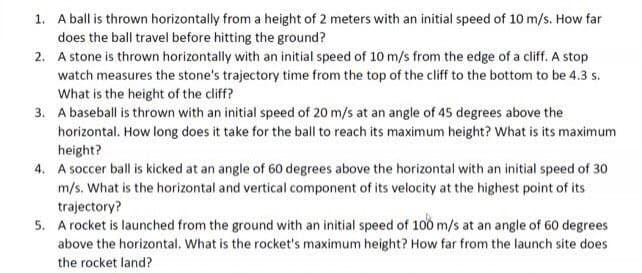1. A ball is thrown horizontally from a height of 2 meters with an initial speed of 10 m/s. How far does the ball travel before hitting the ground? 2. A stone is thrown horizontally with an initial speed of 10 m/s from the edge of a cliff. A stop watch measures the stone's trajectory time from the top of the cliff to the bottom to be 4.3 s. What is the height of the cliff? 3. A baseball is thrown with an initial speed of 20 m/s at an angle of 45 degrees above the horizontal. How long does it take for the ball to reach its maximum height? What is its maximum height? 4. A soccer ball is kicked at an angle of 60 degrees above the horizontal with an initial speed of 30 m/s. What is the horizontal and vertical component of its velocity at the highest point of its trajectory? 5. A rocket is launched from the ground with an initial speed of 100 m/s at an angle of 60 degrees above the horizontal. What is the rocket's maximum height? How far from the launch site does the rocket land?
1. A ball is thrown horizontally from a height of 2 meters with an initial speed of 10 m/s. How far does the ball travel before hitting the ground? 2. A stone is thrown horizontally with an initial speed of 10 m/s from the edge of a cliff. A stop watch measures the stone's trajectory time from the top of the cliff to the bottom to be 4.3 s. What is the height of the cliff? 3. A baseball is thrown with an initial speed of 20 m/s at an angle of 45 degrees above the horizontal. How long does it take for the ball to reach its maximum height? What is its maximum height? 4. A soccer ball is kicked at an angle of 60 degrees above the horizontal with an initial speed of 30 m/s. What is the horizontal and vertical component of its velocity at the highest point of its trajectory? 5. A rocket is launched from the ground with an initial speed of 100 m/s at an angle of 60 degrees above the horizontal. What is the rocket's maximum height? How far from the launch site does the rocket land?
College Physics
1st Edition
ISBN:9781938168000
Author:Paul Peter Urone, Roger Hinrichs
Publisher:Paul Peter Urone, Roger Hinrichs
Chapter3: Two-dimensional Kinematics
Section: Chapter Questions
Problem 34PE: An arrow is shot from a height of 1.5 m toward a cliff of height H. It is shot with a velocity of 30...
Related questions
Concept explainers
Topic Video
Question
Answer 3,4 & 5 only
Typewritt3n please not in photo

Transcribed Image Text:1. A ball is thrown horizontally from a height of 2 meters with an initial speed of 10 m/s. How far
does the ball travel before hitting the ground?
2.
A stone is thrown horizontally with an initial speed of 10 m/s from the edge of a cliff. A stop
watch measures the stone's trajectory time from the top of the cliff to the bottom to be 4.3 s.
What is the height of the cliff?
3. A baseball is thrown with an initial speed of 20 m/s at an angle of 45 degrees above the
horizontal. How long does it take for the ball to reach its maximum height? What is its maximum
height?
4. A soccer ball is kicked at an angle of 60 degrees above the horizontal with an initial speed of 30
m/s. What is the horizontal and vertical component of its velocity at the highest point of its
trajectory?
5. A rocket is launched from the ground with an initial speed of 100 m/s at an angle of 60 degrees
above the horizontal. What is the rocket's maximum height? How far from the launch site does
the rocket land?
Expert Solution
This question has been solved!
Explore an expertly crafted, step-by-step solution for a thorough understanding of key concepts.
This is a popular solution!
Trending now
This is a popular solution!
Step by step
Solved in 3 steps

Knowledge Booster
Learn more about
Need a deep-dive on the concept behind this application? Look no further. Learn more about this topic, physics and related others by exploring similar questions and additional content below.Recommended textbooks for you

College Physics
Physics
ISBN:
9781938168000
Author:
Paul Peter Urone, Roger Hinrichs
Publisher:
OpenStax College

College Physics
Physics
ISBN:
9781305952300
Author:
Raymond A. Serway, Chris Vuille
Publisher:
Cengage Learning

College Physics
Physics
ISBN:
9781938168000
Author:
Paul Peter Urone, Roger Hinrichs
Publisher:
OpenStax College

College Physics
Physics
ISBN:
9781305952300
Author:
Raymond A. Serway, Chris Vuille
Publisher:
Cengage Learning